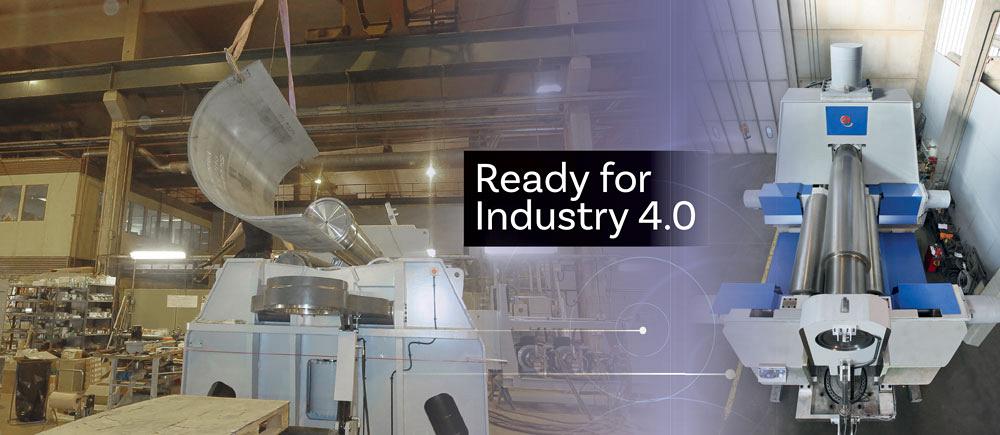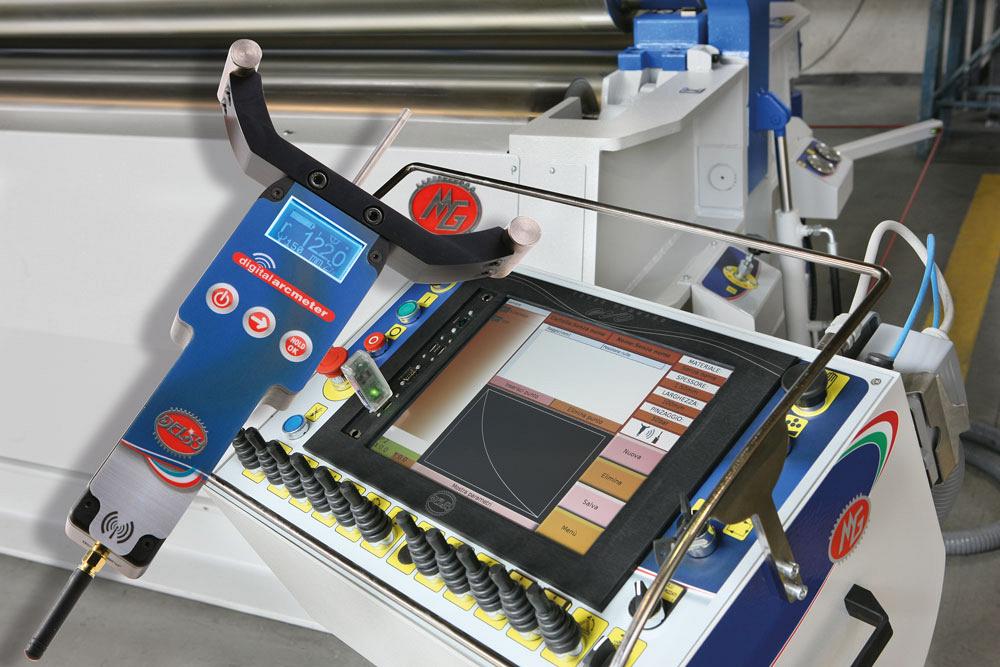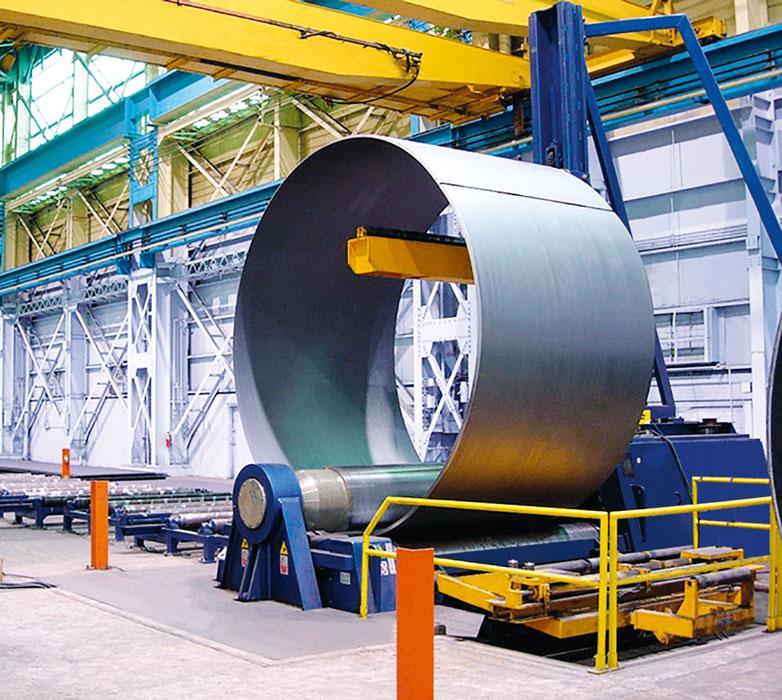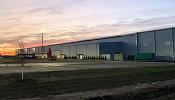Contributing editor
- FMA
- The Fabricator
- FABTECH
- Canadian Metalworking
Categories
- Additive Manufacturing
- Aluminum Welding
- Arc Welding
- Assembly and Joining
- Automation and Robotics
- Bending and Forming
- Consumables
- Cutting and Weld Prep
- Electric Vehicles
- En Español
- Finishing
- Hydroforming
- Laser Cutting
- Laser Welding
- Machining
- Manufacturing Software
- Materials Handling
- Metals/Materials
- Oxyfuel Cutting
- Plasma Cutting
- Power Tools
- Punching and Other Holemaking
- Roll Forming
- Safety
- Sawing
- Shearing
- Shop Management
- Testing and Measuring
- Tube and Pipe Fabrication
- Tube and Pipe Production
- Waterjet Cutting
Industry Directory
Webcasts
Podcasts
FAB 40
Advertise
Subscribe
Account Login
Search
Plate rolling follows trends curves
Ready for Industry 4.0
- By Kate Bachman
- March 5, 2018
- Article
- Bending and Forming

Plate rolling technology continues to evolve to meet demands to roll harder metal grades, tighter radii, larger pieces for new applications such as offshore wind energy, and for simpler operation—in addition to the relentless pressure to accelerate throughput, increase productivity, and to reduce costs. Photos courtesy of SweBend and MG s.r.l.
Plate rolling, the long-established powerhouse technology for curving thick plate steel, continues to roll forward and follow trend curves to respond to changing needs.
Demands to roll harder metal grades, tighter radii, larger pieces for new applications such as offshore wind energy, and for simpler operation—in addition to the relentless pressure for fabricators to accelerate throughput, increase productivity, and to reduce costs—are bending the way that plate rolling machinery is being built.
With more automation, sophisticated controls, machine-to-machine communication, new roll configurations, and more force than ever before, today’s plate rolling technology is ready for the fourth Industrial Revolution, OEMs say.
What challenges are fabricators facing?
Metal fabrication manufacturers face huge challenges and intensified pressure to reduce production time, improve flexibility, increase quality, and reduce energy, said Executive Vice President of Faccin USA Steve Addy. “The plate rolling business is highly competitive, particularly in series production where fabricators are challenged to optimize the cycle to cut production time. They need plate rollers that are fast, precise, reliable, and user-friendly,” he said.
MG s.r.l. President Massimo Roccia indicated that much of what is driving the pressure for higher productivity is the demand for lower costs of rolled fabrications.
Cost and throughput pressures are not all that fabricators are facing, according to Peter Nilsson, founder of SweBend. Customers are demanding that the parts be made of stronger yet lighter materials than they used in the past, including abrasion- and wear-resistant steels. “The main challenges of these materials with high yield strengths is the increased springback throughout the forming process.”
Those demands for cost-downs and throughput increases are occurring even as fabricators are tasked with rolling tighter radii and larger plates.
How is plate rolling technology evolving to help meet fabricators’ challenges?
More Automated, Simpler to Operate. Like so many other technologies, plate rolling technology is moving to encompass automation more extensively to reduce the skill required to operate the machinery and to increase productivity, all of the article contributors agreed.
“For years rolling machines could be used only by expert, skilled operators,” Roccia said. “Now automation is rendering the rolling operation easier to use, and even a nonskilled operator can do a good job. With the simple touch of the screen, even with working gloves on, the operator can enter the sheet parameters and the control will generate the program to bend it.
“Otherwise, the operator can create the bending program itself that the CNC will perform automatically. The system learns the necessary coordinates that are executed automatically with the utmost accuracy and automatically corrects any deviation,” Roccia said.

Figure 1
MG s.r.l.’s Archmeter radius-measuring tool detects the bending radius and sends the data to its CNC Touch Command EVO.
On multiple diameters, the speeds of the interpolated movements are selected in a fully automatic mode and are controlled in every stress and temperature condition in real time during the bending process, Roccia continued. “The closed-loop system allows simultaneous verification of the processes, which is always displayed on the screen,” he said. “If the roller starts to deviate from the position entered, the rotation will increase or slow automatically to ensure that bending is carried out correctly.”
A microchip mounted on the bending-point-focused machine opening allows the operator to display the result. The EVO control monitors the machine status and reports when adjustments are needed (see Figure 1). The MG Archmeter detects the bending radius and sends the data to the CNC via Wi-Fi connection, Roccia reported.
SweBend has developed powerful yet easy-to-operate CNC software, according to Nilsson. “The software is icon-driven, meaning that the operator does not have to be a computer programmer to be able to roll even the most complicated parts like square tanks and ellipses in one pass,” he said.
Addy said that Faccin foresaw the need for the metal forming industry to have computer-controlled rolling machines in the early 1980s and developed its first generation of CNC bending rolls. “Today CNC machines can be found in almost all industries, from small-scale metalworking shops to big manufacturing companies. Barely any phase of the manufacturing process is not affected by automated CNC machines.”
Faccin developed its PGS-Ultra CNC to improve the automation for its plate rolls. It is built with industrial Siemens hardware and a user-friendly graphic interface. The CNC makes running a different workpiece as easy as selecting it from a different shape option on the screen, Addy said. Operators can build programs for rolling variable thicknesses, calculating the plate length, cycle time, and so forth. Once a program has been verified and executed for a production run, it can be recalled the next time the workpiece is to be run to expedite changeover. That shortens setup time, which helps fabricators meet today’s just-in-time production schedules.
Because the rolling machine runs under program control, the skill level required of the operator is reduced, which decreases the dependence on a single, highly skilled operator, Addy said. “It is so simple to use that even an inexperienced operator can program the rolling machine to produce simple circular shapes of different diameters and lengths or more complex pieces like polycentric tanks, spirals for ventilators, and plates of variable lengths.”
Furthermore, a CNC plate roll can run unattended during most of its rolling cycle, he asserted. “This frees the operator to do other tasks and reduces operator fatigue and mistakes triggered by human error,” Addy said.
Machine accessories like a feeding table, plate centering, lateral and top supports, and clamping devices can be controlled with the CNC through a simplified motion control feature that manages 15 programmable directions (axes), Addy said.
Larger Parts, Thicker Materials. As wind energy turbines have gotten larger and more powerful, the cones for the plate-rolled tower sections and cans have gotten larger too. Fabricators are having to bend conical and cylindrical plates with very large diameters and thicknesses. The plate rolling industry developed some devices to eliminate problems related to weight and size. For example, devices were developed to support the plate during rolling to prevent it from collapsing under its own weight, and to avoid the need to use an overhead crane.
“Faccin plate rolling machines’ oversized structure and components, efficient cooling systems, and centralized lubrication help them perform well under heavy loads,” Addy said.

Figure 2
This SweBend model PB4-12-4 has 12-in.-dia., 4-ft.-long rolls. Its drive torque is higher than standard, and its extra-strong top support and smaller-than-standard top roll allow fabricators to roll a smaller radius than would otherwise be possible—15-in. by 1-in. high-strength steel to 15 in. ID.
Conical, and Tighter Radii. With demands to roll tighter radii and tougher material, off-the-shelf approaches won’t cut it anymore, SweBend’s Nilsson said. “Out-of-date bending roll types just are not capable of rolling tight radii without also producing long, costly flat scrap ends. SweBend attacks the problem head-on by building customized four-roll plate rolls with a smaller-diameter top roll to more efficiently and effectively roll the specified diameters, while leaving the shortest flat end physically achievable (see Figure 2). This change in the plate rolls calls for tighter machine geometries, more advanced engineering, and puts higher force and torque demands on components,” he said.
To enhance the ability to roll tighter radii, MG’s PH bending machine has three variable-axis motorized rollers. The upper roller moves on its vertical axis and behaves like a press in contact with the side rollers moving on their horizontal axis, explained Roccia. The lateral rollers can get closer to the top, which helps to bend the pieces with minimal power. “It can roll extremely small diameters on very thick plate and is suitable for processing conical and even eccentric shapes,” Roccia said. “Though this type of plate roller was developed some years ago as an alternative to traditional four-rollers, today’s CNC upgrades provide even more precise control. They can auto-calculate all the different shapes.”
Faccin machines’ geometry and controls are engineered to perform prebending and to achieve tight tolerances to minimize the rerolling percentage of the cones, Addy said.
High-strength Materials. To overcome springback, more bending power is required, Nilsson said. “To keep up with the ever-increasing power demands of the material that fabricators are using, SweBend has completely re-engineered its plate roll lineup to offer machines with more bending power and drive torque.”
In addition, the company’s CNC is intended to handle an almost unlimited number of help functions.
The machinery is equipped with critically important support rolls under the lower roll that adjusts its crowning. This support also widens the range of thicknesses that can be rolled on the machine successfully, Nilsson said.
Often, in theory, although two different coils can have identical grade descriptions and should have identical properties, in reality they can have different characteristics that produce uneven bending results. “To remedy this, the MG CNC Touch Command EVO on our machines performs a sheet metal test quickly, which leads to optimal results from the first tested piece,” Roccia said.
Increased Productivity, Speed. In addition to the speed gained by automation, expedited steps, and single-operator handling, the machines have been re-engineered specifically for faster operation, the OEMs said.
Addy said that Faccin has engineered its hydraulic systems for speed and power to improve rolling quality and save time in subsequent processes like assembly and welding, thus increasing productivity while cutting costs.
Nilsson said that a four-roll plate roll machine is faster and more efficient than a three-roll double-pinch machine or a three-roll variable-geometry machine.

Faccin’s SMART Package 4.0 offers systems diagnosis, teleservice, management control, drawing imports, rolling and production lot statistics, and flexible networking.
Which plate rolling innovations can metal fabricators expect to see emerging?
MG’s Roccia said, “The term Industry 4.0 is slowly entering our vocabulary to name a phenomenon that is affecting the world we live in—a fourth Industrial Revolution.
“Real-time exchange and analysis; virtually unlimited internet connections; digitized supports; and advanced information and communications technology, expressed in digital devices, software programs, and telecommunications, redefine today’s entire business,” Roccia said.
MG’s control enables wireless communication, interconnection, data collection, and analysis in real time, as well as visualization of the desired shape in 3-D graphics. Roccia added that he thinks that the next innovation will be the automatic rolling of conical shapes, both regular and eccentric.
SweBend’s Nilsson added, “Metal fabricators should expect their plate roll supplier to become more of a partner in their business, rather than a one-time ‘sell it and forget it’ relationship. To achieve the optimal solution for these challenges, we see the increasing importance of truly collaborating with our customers to tailor their machines for both their present and future needs.”
Addy said that Faccin is ready for Industry 4.0 with its SMART Package 4.0 that offers systems diagnosis, teleservice, management control, drawing imports, rolling and production lot statistics, and flexible networking. “We are helping the manufacturers of today face the challenges of tomorrow.”
Faccin, www.faccin.com
MG s.r.l., www.mgsrl.com
SweBend, represented by Trilogy Machinery, www.trilogymachinery.com/swebend.htm
About the Author

Kate Bachman
815-381-1302
Kate Bachman is a contributing editor for The FABRICATOR editor. Bachman has more than 20 years of experience as a writer and editor in the manufacturing and other industries.
subscribe now

The Fabricator is North America's leading magazine for the metal forming and fabricating industry. The magazine delivers the news, technical articles, and case histories that enable fabricators to do their jobs more efficiently. The Fabricator has served the industry since 1970.
start your free subscription- Stay connected from anywhere

Easily access valuable industry resources now with full access to the digital edition of The Fabricator.

Easily access valuable industry resources now with full access to the digital edition of The Welder.

Easily access valuable industry resources now with full access to the digital edition of The Tube and Pipe Journal.
- Podcasting
- Podcast:
- The Fabricator Podcast
- Published:
- 05/07/2024
- Running Time:
- 67:38
Patrick Brunken, VP of Addison Machine Engineering, joins The Fabricator Podcast to talk about the tube and pipe...
- Industry Events
Laser Welding Certificate Course
- May 7 - August 6, 2024
- Farmington Hills, IL
World-Class Roll Forming Workshop
- June 5 - 6, 2024
- Louisville, KY
Advanced Laser Application Workshop
- June 25 - 27, 2024
- Novi, MI
Precision Press Brake Certificate Course
- July 31 - August 1, 2024
- Elgin,































